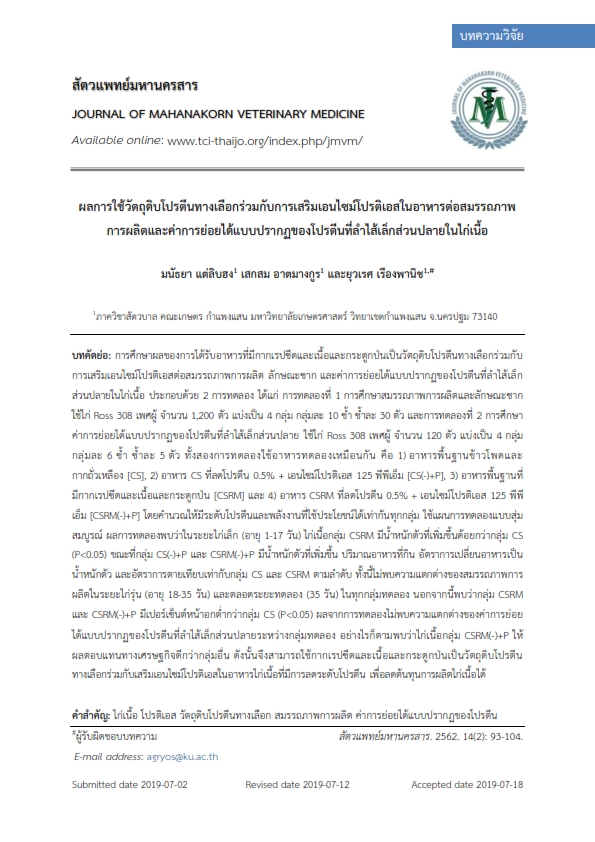Effect of Using Alternative Protein Feedstuffs with Protease Supplementation in Diet on Growth Performance and Apparent Ileal Protein Digestibility of Broilers
Main Article Content
Abstract
Two studies were conducted to evaluate the use of rapeseed meal and meat and bone meal as alternative protein feedstuffs with protease supplementation on growth performance, carcass traits and apparent ileal protein digestibility (AID) in broiler. Experiment 1, Broiler performance and carcass traits were evaluated using 1,200 male Ross 308 broilers. All birds were randomly divided into 4 dietary treatments with 10 replications (30 birds/replication). Experiment 2, AID was studied using 120 male Ross 308 broilers fed with 4 dietary treatments as in Experiment 1. Each treatment consisted with 6 replications (5 birds/replication). The dietary treatments were 1) corn-soybean basal diet [CS], 2) CS with reduced 0.5% CP+125 ppm. protease [CS(-)+P], 3) CS with rapeseed meal and meat and bone meal [CSRM] and 4) CSRM with reduced 0.5% CP+125 ppm. protease [CSRM(-)+P]. All diets were formulated to be isonitrogenous and isocaloric. Both experiments were assigned in CRD. During starter period (1-17 DOA), CSRM birds had lower BWG than that of the CS group (P<0.05). Whereas CS(-)+P and CSRM(-)+P groups had BWG, feed intake, FCR and mortality rate similar to that of the CS and CSRM groups, respectively. There was no significant difference of growth performance among dietary treatments during grower period (18-35 DOA) and throughout the experimental period (35 days). Percentage of breast yield was significantly lower in CSRM and CSRM(-)+P groups than that of the CS group (P<0.05). However, no significant difference of AID was observed among dietary treatments. Birds fed CSRM(-)+P diet had better ROI than the other groups. Therefore, rapeseed meal and meat and bone meal are able to be incorporated as alternative protein feedstuffs in broiler diet containing lower CP supplemented with protease to reduce production cost of broilers.
Article Details
References
Angel, R. and J. O. B. Sorbara. 2014. Why is it important to understand substrates if we are to optimize exogenous enzyme efficacy? Poult. Sci. 93: 2375-2379.
Aviagen. 2014. Ross 308 Broiler Nutrition Specifications. Available Source: https://en.aviagen.com/assets/Tech_Center/Ross_Broiler/Ross308BroilerNutritionSpecs2014-EN.pdf, March 5, 2016.
Haase, V. H. 2010. Hypoxic regulation of erythropoiesis and iron metabolism. Am. J. Physiol. Renal. Physiol. 299: F1-F13.
Kaczmarek, S. A., A. Barri, M. Hejdysz, and A. Rutkowski. 2016. Effect of different doses of coated butyric acid on growth performance and energy utilization in broilers. Poult. Sci. 95: 851-859.
Khattak, F. M., T. N. Pasha, Z. Hayat, and A. Mahmud. 2006. Enzymes in poultry nutrition. J. Anim. Pl. Sci. 16(1-2): 1-7.
Liu, M. 2000. Nutritional evaluation of high ash meat and bone meal for poultry. MS Thesis, University of Manitoba Winnipeg, Canada.
Meng, X., B. A. Slominski, C. M. Nyachoti, L. D. Campbell, and W. Guenter. 2005. Degradation of cell wall polysaccharides by combinations of carbohydrase enzymes and their effect on nutrient utilization and broiler chicken performance. Poult. Sci. 84: 37-47.
Miraglia, D., R. Mammoli, R. Branciari, D. Runucci, and B.T. Cenci Goga. 2006. Characterization of muscle fiber type and evaluation of the presence of giant fibres in two meat chicken hybrids. Vet. Res. Commun. 30(Suppl. 1): 357-360.
Organisation for Economic Co-operation and Development and Food and Agriculture Organization of the United Nations (OECD-FAO). 2018. OECD-FAO Agricultural Outlook 2018-2027. OECD Publishing. Paris. 107 p.
Rada, V., M. Foltyn, M. Lichovnikova, and A. Musilova. 2013. Effects of protease supplementation of low protein broiler diets on growth parameters and carcass characteristic. Proceedings of International PhD Students Conference, Mendel University in Brno, Czech Republic, 20-21 November 2013: 268-272.
Salazar-Villanea, S., E. M. A. M. Bruininx, H. Gruppen, W. H. Hendriks, P. Carré, A. Quinsac and A. F. B. van der Poel. 2016. Physical and chemical changes of rapeseed meal protein during toasting and their effects on in vitro digestibility. J. Anim. Sci. Biotechnol. 7: 62.
Ward, N. E. 2014. Choosing enzyme solution depends on many factors. Feedstuffs 86: 1-4.
West, G. and G. Norton. 1991. Rapeseed proteinase inhibitors, pp. 928-933. Proceeding of the 8th International Rapeseed Congress. Saskatchewan, Canada.
Yan, F., J. Dibner, C. D. Knight, M. Vazquez-Anon, N. Odetallah, and S. Carter. 2011. Effect of dietary protein and protease supplementation on performance and gut health of broiler chicks. Poult. Sci. 90(E-Suppl. 1): 19.
Yuan, L., S. Q. Wang, Z. X. Wang, H. Zhu, and K. Huang. 2015. Effects of exogenous protease supplementation on endogenous trypsin activity and gene expression in broilers. Genet. Mol. Res. 14: 13633-13641.


